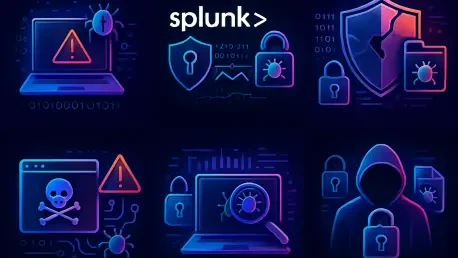In a digital landscape where data analytics platforms are integral to organizational operations, the recent discovery of critical vulnerabilities in Splunk Enterprise and Splunk Cloud Platform has raised significant alarms across the cybersecurity community. These flaws, disclosed earlier this month, expose systems to severe risks, including remote JavaScript injection and unauthorized data access, threatening the integrity of sensitive information. As enterprises increasingly rely on Splunk for monitoring and insights, the urgency to address these security gaps cannot be overstated. The implications of such vulnerabilities extend beyond mere technical disruptions, potentially leading to compromised user sessions and substantial data breaches. This situation underscores a persistent challenge in securing complex software against sophisticated cyber threats, prompting a closer examination of the specific issues at hand and the necessary steps to mitigate them.
Understanding the Scope of the Vulnerabilities
Critical Flaws Across Multiple Components
The security advisory from Splunk highlights six severe vulnerabilities affecting various components of Splunk Web, posing diverse threats to system integrity. Ranging from cross-site scripting (XSS) to server-side request forgery (SSRF), these flaws also include improper access control, XML External Entity (XXE) injection, and denial-of-service (DoS) risks. Each issue targets different facets of the platform, from web interfaces to internal endpoints, impacting versions below 9.4.4, 9.3.6, 9.2.8, and including 10.0.0 for Splunk Enterprise, alongside specific builds of Splunk Cloud Platform. The breadth of these vulnerabilities illustrates the multifaceted nature of cybersecurity challenges in enterprise environments, where a single unaddressed gap can serve as an entry point for attackers. The potential for exploitation by both low-privileged users and unauthenticated actors amplifies the severity, making it imperative for organizations to grasp the full scope of these risks and their operational implications.
Exploitation Risks and Attack Vectors
Delving deeper into the exploitation potential, two XSS vulnerabilities stand out due to their ability to execute malicious JavaScript in user browsers. Identified as CVE-2025-20367 and CVE-2025-20368, both with a CVSS score of 5.7, these flaws enable attackers to craft payloads that compromise user sessions or steal sensitive data through reflected and stored attacks, respectively. Additionally, an unauthenticated blind SSRF issue, tagged as CVE-2025-20371 with a higher CVSS score of 7.5, allows REST API calls on behalf of high-privileged users, often via social engineering tactics. These attack vectors reveal how seemingly minor configuration oversights can lead to significant breaches, emphasizing the need for stringent security measures. The diversity of methods through which attackers can exploit these vulnerabilities highlights a critical lesson in the importance of proactive defense strategies to safeguard against evolving cyber threats.
Mitigation Strategies and Security Responses
Immediate Actions for System Protection
In response to these alarming vulnerabilities, Splunk has rolled out patched versions—10.0.1, 9.4.4, 9.3.6, and 9.2.8—for Enterprise users, while automatic updates are being applied for Cloud Platform clients. For organizations unable to upgrade immediately, temporary mitigations have been advised, such as disabling Splunk Web or adjusting specific settings like setting enableSplunkWebClientNetloc to false to curb SSRF risks. Restricting certain capabilities, such as change_authentication, can also mitigate DoS threats related to LDAP bind requests. These interim measures offer a practical approach to reducing exposure while long-term solutions are implemented. However, the emphasis remains on upgrading to the latest versions as the most effective defense, ensuring that systems are fortified against the identified flaws and preventing potential disruptions or data leaks that could arise from delayed action.
Long-Term Security Enhancements
Beyond immediate fixes, the situation calls for a broader reevaluation of security practices within organizations using Splunk platforms. Strengthening user permission management emerges as a critical focus, given that several vulnerabilities can be exploited by low-privileged users through mechanisms like guessing Search IDs (SIDs) to access sensitive results. Adopting robust role-based access controls can significantly limit the attack surface, preventing unauthorized access to critical data. Furthermore, maintaining a routine of regular updates and patches should become standard practice, alongside implementing defense-in-depth strategies to address potential weaknesses across all system layers. This incident serves as a reminder that cybersecurity is an ongoing process, requiring continuous vigilance and adaptation to counter sophisticated threats. By prioritizing these long-term enhancements, enterprises can better protect their environments from similar vulnerabilities in the future.
Lessons Learned for Future Preparedness
Reflecting on the disclosure, it became evident that proactive security measures were essential in preventing the exploitation of such critical flaws in Splunk systems. The urgency with which patches were applied and mitigations were deployed underscored the importance of rapid response mechanisms in cybersecurity frameworks. Organizations that had established protocols for monitoring advisories and implementing updates managed to minimize their exposure to risks like XSS and SSRF attacks. This experience also highlighted how vital it was to educate teams on the significance of configuration settings and access controls, as many exploits stemmed from oversights in these areas. Looking back, the collaborative efforts between Splunk and its user base to address these issues set a precedent for handling future vulnerabilities with efficiency and transparency, ensuring that lessons from this incident shape more resilient security postures across the industry.









